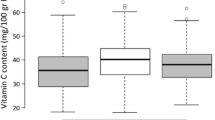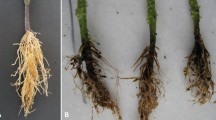Abstract
Ripening represents a complex developmental process unique to plants. We are using tomato fruit ripening mutants as tools to understand the regulatory components that control and coordinate the physiological and biochemical changes which collectively confer the ripe phenotype. We have genetically characterized two loci which result in significant inhibition of the ripening process in tomato,ripening-inhibitor (rin), andnon-ripening (nor), as a first step toward isolating genes likely to encode key regulators of this developmental process. A combination of pooled-sample mapping as well as classical restriction fragment length polymorphism (RFLP) analysis has permitted the construction of high-density genetic maps for the regions of chromosomes 5 and 10 spanning therin andnor loci, respectively. To assess the feasibility of initiating a chromosome walk, physical mapping of high molecular weight genomic DNA has been employed to estimate the relationship between physical distance (in kb) and genetic distance (in cM) around the targeted loci. Based on this analysis, the relationship in the region spanning therin locus is estimated to be 200–300 kb/cM, while thenor locus region ratio is approximately 200 kb/1 cM. Using RFLP markers tightly linked torin andnor, chromosome walks have been initiated to both loci in a yeast artificial chromosome (YAC) library of tomato genomic DNA. We have isolated and characterized several YAC clones linked to each of the targeted ripening loci and present genetic evidence that at least one YAC clone contains thenot locus.
Similar content being viewed by others
References
Allard RW (1956) Formulas and tables to facilitate the calculation of recombination values in heredity. Hilgardia 24:235–278
Arondel V, Lemieux B, Hwang I, Gibson S, Goodman HN, Somerville CR (1992) Map-based cloning of gene controlling omega-3 fatty acid desaturation inArabidopsis. Science 258:1353–1355
Burke D, Carle G, Olson M (1987) Cloning of large segments of exogenous DNA into yeast by means of artificial chromosome vectors. Science 236: 806–812
Chang C, Kwok SF, Bleecker AB, Meyerowitz EM (1993)Arabidopsis ethylene-response gene ETR1: similarity of product to twocomponent regulators. Science 262:539–545
Churchill GA, Giovannoni JJ, Tanksley SD (1993) Pooled-sample mapping makes high resolution mapping practical with DNA markers. Proc Natl Acad Sci USA 90:16–20
DellaPenna D, Lincoln JE, Fischer RL, Bennett AB (1989) Transcriptional analysis of polygalacturonase and other ripening associated genes in Rutgers, rin, nor, and Nr tomato fruit. Plant Physiol 90:1372–1377
Ganal MW, Tanksley SD (1989) Analysis of tomato DNA by pulsed field gel electrophoresis. Plant Mol Biol Rep 7:17–27
Ganal MW, Young ND, Tanksley SD (1989) Pulsed field gel electrophoresis and physical mapping of large DNA fragments in theTm-2a region of chromosome 9 in tomato. Mol Gen Genet 215:395–400
Giovannoni J (1993) Molecular and genetic analysis of tomato fruit development and ripening. Methods Plant Biochem 10:251–285
Giovannoni J, DellaPenna D, Bennett A, Fischer R (1989) Expression of a chimeric polygalacturonase gene in transgenicrin (ripening inhibitor) tomato fruit results in polyuronide degradation but not fruit softening. The Plant Cell 1: 53–63
Giovannoni JJ, Wing RA, Ganal MW, Tanksley SD (1991) Isolation of molecular markers from specific chromosomal intervals using DNA from existing mapping populations. Nucleic Acids Res 19 6553–6558
Giraudat J, Hauge BM, Valon C, Smalle J, Parcy F, Goodman HM (1992) Isolation of theArabidopsis AB13 gene by positional cloning. Plant Cell 4:1251–1261
Gray JE, Picton S, Shabbeer J, Schuch W, Grierson D (1992) Molecular biology of fruit ripening and its manipulation with antisense genes. Plant Mol Biol 19:69–87
Gray JE, Picton S, Giovannoni JJ, Grierson D (1994) The use of transgenic and naturally occurring mutants to understand and manipulate tomato fruit ripening. Plant Cell Environ 17: 557–571
Grierson D (1986) Molecular biology of fruit ripening. Ox Surv Plant Mol Cell Biol 3:363–383
Harriman R, Handa A (1991) Molecular cloning of tomato pectin methylesterase gene and its expression in Rutgers, ripening inhibitor, nonripening and Never ripe tomato fruits. Plant Physiol 97:80–87
Hobson G, Grierson D (1993) Tomato. In: Seymour GB, Taylor JE, Tucker GA (eds) Biochemistry of fruit ripening. Chapman and Hall, London, pp 405–442
Kieber J, Rothenberg M, Roman G, Feldman K, Ecker J (1993)CTR1, a negative regulator of the ethylene response pathway inArabidopsis, encodes a member of the Raf family of protein kinases. Cell 72:427–441
Kinzer SM, Schwager SJ, Mutschler MA (1990) Mapping of ripening-related or -specific cDNA clones of tomato (Lycopersicon esculentum). Theor Appl Genet 79:489–496
Klee HJ, Hayford MB, Kretzmer KA, Barry GF, Kishore GM (1991) Control of ethylene synthesis by expression of a bacterial enzyme in transgenic tomato plants. Plant Cell 3:1187–1193
Kosgmbi DD (1944) The estimation of map distances from recombination values. Ann Eugen 12:172–175
Lanahan MB, Yen HC, Giovannoni JJ, Klee HJ (1994) The NeverRipe mutation blocks ethylene perception in tomato. Plant Cell 6:521–530
Lander ES, Green P, Abrahamson J, Barlow A, Daly MJ, Lincoln SE, Newburn L (1987) MAPMAKER: An interactive computer package for constructing primary genetic linkage maps of experimental and natural populations. Genomics 1: 174–181
Lincoln J, Fischer R (1988) Regulation of gene expression by ethylene in wild-type and rin tomato (Lycopersicon esculentum) fruit. Plant Physiol 88:370–374
Martin GB, Ganal MW, Tanksley SD (1992) Construction of a yeast artificial chromosome library of tomato and identification of cloned segments linked to two disease resistance loci. Mol Gen Genet 233:25–32
Martin G, Brommonschenkel S, Chunwongse J, Frary A, Ganal M, Spivey R, Wu T, Earle E, Tanksley S. (1993) Map-based cloning of a protein kinase gene conferring disease resistance in tomato. Science 262:1432–1436
Ochman H, Gerber A, and Hartl D (1988) Genetic applications of an inverse polymerase chain reaction. Genetics 120:621–623
Oeller PW, Wong LM, Taylor LP, Pike DA, Theologis A (1991) Reversible inhibition of tomato fruit senescence by antisense 1-aminocyclopropane-1-carboxylate synthase. Science 254:427–439
Picton S, Barton SL, Bouzayen M, Hamilton AJ, Grierson D (1993a) Altered fruit ripening and leaf senescence in tomatoes expressing an antisense ethylene-forming enzyme transgene. Plant J 3:469–481
Picton S, Gray JE, Barton SL, AbuBaker U, Lowe A, Grierson D (1993b) cDNA cloning and characterization of novel ripeningrelated mRNAs with altered patterns of accumulation in the ripening inhibitor (rin) tomato ripening mutant. Plant Mol Biol 23:193–207
Rhodes MJC (1980) The maturation and ripening of fruits. In: KV Thimann (ed) Senescence in plants. CRC Press, Boca Raton, FL, pp 157–205
Rick CM (1980) Tomato linkage survey. Rep Tomato Genet Coop 30:2–17
Robinson RW, Tomes ML (1968) Ripening-inhibitor: a gene with multiple effects on ripening. Rep Tomato Genet Coop 18:36
Tanksley SD, Ganal MW, Prince JP, de Vicente MC, Bonierbale MW, Broun P, Fulton TM, Giovannoni JJ, Grandillo S, Martin GB, Messeguer R, Miller JC, Miller L, Paterson AH, Pineda O, Röder MS, Wing RA, Wu W, Young ND (1992) High density molecular linkage maps of the tomato and potato genomes. Genetics 132:1141–1160
Theologis A (1993) One rotten apple spoils the whole bushel: the role of ethylene in fruit ripening. Cell 70:181–184
Tigchelaar E, Tomes M, Kerr E, Barman R (1973) A new fruit ripening mutant, non-ripening (nor). Rep Tomato Genet Coop 23:33
Tigchelaar EC, McGlasson WB, Buescher RW (1978) Genetic regulation of tomato fruit ripening. Hort Sci 13:508–513
Tucker GA, Brady CJ (1987) Silver ions interrupt tomato fruit ripening. J Plant Physiol 127:165–169
Wing RA, Zhang HB, Tanksley SD (1994) Map-based cloning in crop plants. Tomato as a model system: I. genetic and physical mapping of jointless. Mol Gen Genet 242:681–688
Yang SF (1985) Biosynthesis and action of ethylene. Hort Sci 20:41–45
Yen HC, Lee S, Tanksley SD, Lanahan MB, Klee HJ, Giovannoni, J (1995) The tomatoNever-ripe locus regulates ethyleneinducible gene expression and is linked to a homologue of theArabidopsis ETR1 gene. Plant Physiol 107:1343–1353
Author information
Authors and Affiliations
Additional information
Communicated by H. Saedler
Rights and permissions
About this article
Cite this article
Giovannoni, J.J., Noensie, E.N., Ruezinsky, D.M. et al. Molecular genetic analysis of theripening-inhibitor andnon-ripening loci of tomato: A first step in genetic map-based cloning of fruit ripening genes. Molec. Gen. Genet. 248, 195–206 (1995). https://doi.org/10.1007/BF02190801
Received:
Accepted:
Issue Date:
DOI: https://doi.org/10.1007/BF02190801




